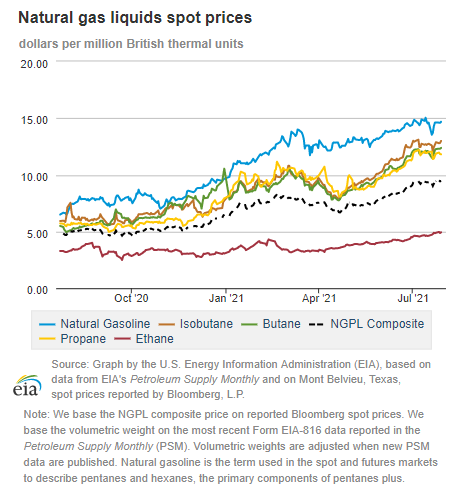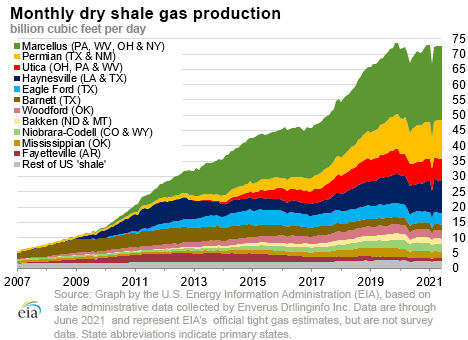In the News:
Japan highlights hydrogen power at the Tokyo 2020 Olympics and continues to diversify fuel sources
Japan is highlighting the use of hydrogen during this year’s Summer Olympic Games held in Tokyo. When Japan first hosted the Olympics in 1964, Japan used propane gas in the Olympic cauldron. For this year's Olympic Games, the cauldron is fueled by a mix of hydrogen and propane. In addition, hydrogen is being used in 500 fuel cell vehicles to transport officials and in 100 fuel cell buses to transport athletes. Hydrogen from fuel cells is powering part of the Olympic Village, Harumi Flag, as well. The hydrogen used at the Tokyo 2020 Olympics is produced using solar power generated in Fukushima Prefecture, where the now idle Fukushima Daiichi Nuclear Power Plant is located.
According to Japan’s commitments under the Paris Agreement, Japan has committed to reducing its greenhouse gas (GHG) emissions by 46% by 2030, relative to 2013 emission levels. In addition to these goals, Japan's Ministry of Economy, Trade, and Industry (METI) is working towards net zero emissions by 2050 and has produced a hydrogen strategy to help meet this target. Hydrogen as an energy carrier does not emit greenhouse gas (GHG) emissions when consumed, and it can be produced with current technology from both nonrenewable and renewable resources.
Japan wants to make hydrogen as cost competitive as LNG power generation. Part of Japan’s plans is to reduce the cost to create, transport, and store hydrogen by using ammonia. Ammonia is far less expensive to transport since it can be liquefied and transported under similar conditions as propane. Ammonia can then be used directly as a fuel such as in power turbines. In May, Japanese power generation company JERA started using ammonia as fuel in a large-scale commercial coal-fired plant as a part of a four-year test project. Alternatively, ammonia can be reconverted back to hydrogen. Blue ammonia, which is produced from natural gas with the use of carbon capture and sequestration to avoid GHG emissions, is already being imported by Japan from Saudi Arabia. Eventually, Japan plans to import green ammonia, which would be produced from hydrogen obtained through the electrolysis of water using renewable electricity.
Japan is a major energy importer, with few conventional resources. In 2018, Japan imported close to 88% of its energy requirements. Japan’s imports have grown following the 2011 earthquake and accompanying tsunami that led to the accident at the Fukushima Daiichi Nuclear Power Plant. That accident temporarily or permanently shut down most of Japan’s nuclear reactor fleet. Since the accident, the share of nuclear power in total electricity generation has only increased to 4% in 2020 from 25% in 2010 prior to the accident. An increase in generation from coal, natural gas, and renewables offsets the reduction in nuclear electricity generation. The share of total electricity generation from these fuels increased by 3%, 7%, and 9% respectively, from 2010 to 2020.
Overview:
(For the week ending Wednesday, July 28, 2021)
- Natural gas spot price movements were mixed this report week (Wednesday, July 21 to Wednesday, July 28). The Henry Hub spot price rose from $3.91 per million British thermal units (MMBtu) last Wednesday to $4.05/MMBtu yesterday.
- The August 2021 NYMEX contract expired yesterday at $4.044/MMBtu, up 8¢/MMBtu from last Wednesday, and topped $4.00/MMBtu for the fourth time this month. The September 2021 NYMEX contract price increased to $3.967/MMBtu, up 3¢/MMBtu from last Wednesday to yesterday. The price of the 12-month strip averaging September 2021 through August 2022 futures contracts climbed 6¢/MMBtu to $3.685/MMBtu.
- The net injections to working gas totaled 36 billion cubic feet (Bcf) for the week ending July 23. Working natural gas stocks totaled 2,714 Bcf, which is 16% lower than the year-ago level and 6% lower than the five-year (2016–2020) average for this week.
- The natural gas plant liquids composite price at Mont Belvieu, Texas, rose by 21¢/MMBtu, averaging $9.44/MMBtu for the week ending July 28. Ethane prices rose 4%, which was less than the 7% natural gas price increase at the Houston Ship Channel, narrowing the ethane premium to natural gas by 9% on a heat-value parity. Propane prices remained relatively unchanged as strong production was balanced by elevated exports. Normal butane prices rose 4%, and isobutane and natural gasoline prices rose 3%, following the 3% increase in Brent crude oil prices.
- According to Baker Hughes, for the week ending Tuesday, July 20, the natural gas rig count remained flat at 104. The number of oil-directed rigs rose by 7 to 387, increasing by 7 the total rig count, which now stands at 491.
Prices/Supply/Demand:
Gulf Coast prices increase again this week along with increasing consumption in the Southeast. This report week (Wednesday, July 21 to Wednesday, July 28), the Henry Hub spot price rose 14¢ from $3.91/MMBtu last Wednesday to $4.05/MMBtu yesterday. According to data from IHS Markit, consumption of natural gas in the Southeast increased 4.7% driven by a 7.3% increase in the electric power sector.
Heat persists in the West, increasing prices. The price at PG&E Citygate in Northern California rose 19¢, up from $5.36/MMBtu last Wednesday to $5.55/MMBtu yesterday. The price at SoCal Citygate in Southern California increased 79¢ from $7.52/MMBtu last Wednesday to $8.31/MMBtu yesterday. High temperatures and cooling demand persisted in the West this week. Consumption of natural gas in the electric power sector increased in the West 3.5%, according to data from IHS Markit, and the California Independent System Operator (CAISO) issued a Flex Alert for July 28 on expectations of increased electricity demand in Northern California because of high temperatures.
Midwest prices again increase this week. At the Chicago Citygate, the price increased 10¢ from $3.76/MMBtu last Wednesday to $3.86/MMBtu yesterday, following the Henry Hub price which increased 14¢ over the same period.
Mild temperatures and less consumption of natural gas in the electric power sector put downward pressure on prices in the Northeast. At the Algonquin Citygate, which serves Boston-area consumers, the price went down 23¢ from $3.27/MMBtu last Wednesday to $3.04/MMBtu yesterday. At the Transcontinental Pipeline Zone 6 trading point for New York City, the price decreased 15¢ from $3.27/MMBtu last Wednesday to $3.12/MMBtu yesterday. Temperatures were mild this week in the Northeast with daily averages ranging from 72°F on Thursday 7/22 to 82°F on Monday 7/26 in Boston. Northeast consumption of natural gas in the electric power sector decreased 3.0% this week, according to data from IHS Markit.
Pipeline constraints lower prices in the Appalachia Basin. The Tennessee Zone 4 Marcellus spot price decreased 18¢ from $2.90/MMBtu last Wednesday to $2.72/MMBtu yesterday. The price at Eastern Gas South in southwest Pennsylvania fell 21¢ from $3.04/MMBtu last Wednesday to $2.83/MMBtu yesterday. Maintenance on the Tennessee Gas pipeline at stations 110 and 204 is scheduled this week and is expected to affect southbound flows of natural gas through Kentucky.
Prices in the Permian Basin increase as pipeline constraints ease. The price at the Waha Hub in West Texas, which is located near Permian Basin production activities, averaged $3.74/MMBtu last Wednesday, 17¢/MMBtu lower than the Henry Hub price. Yesterday, the price at the Waha Hub increased 18¢ to $3.92/MMBtu, 13¢/MMBtu lower than the Henry Hub price. The force majeure declared on Thursday, July 15, in association with the Waha compressor station on the El Paso pipeline was lifted on Thursday, July 22, relieving constraints on natural gas flows west from the Permian Basin.
U.S. total supply of natural gas rose slightly this week. According to data from IHS Markit, the average total supply of natural gas rose by 0.2% compared with the previous report week. Dry natural gas production decreased by 0.4% compared with the previous report week to average 92.6 billion cubic feet per day (Bcf/d). Average net imports from Canada increased by 11.1%, or 1.0 Bcf/d from last week.
U.S. consumption of natural gas increases driven by the electric power sector. Total U.S. consumption of natural gas rose by 3.6% compared with the previous report week’s increase of 1.5%, according to data from IHS Markit. Natural gas consumed for power generation climbed by 5.8% week over week, or 2.2 Bcf/d, nearly matched by a 5.7% increase, or 0.4 Bcf/d, in consumption in the residential and commercial sectors. U.S. maximum temperatures continued to be higher than normal across parts of the western and northern United States. Industrial sector consumption is the only sector that decreased in the past week, by 1.3%. Natural gas exports to Mexico were the same as last week, averaging 6.3 Bcf/d. Natural gas deliveries to U.S. liquefied natural gas (LNG) export facilities (LNG pipeline receipts) averaged 10.7 Bcf/d, or 0.31 Bcf/d higher than last week.
U.S. LNG exports decrease week over week. Nineteen LNG vessels (seven from Sabine Pass, four from Corpus Christi, three each from Cameron and Freeport, and two from Cove Point) with a combined LNG-carrying capacity of 70 Bcf departed the United States between July 22 and July 28, 2021, according to shipping data provided by Bloomberg Finance, L.P.
Storage:
The net injections into storage totaled 36 Bcf for the week ending July 23, compared with the five-year (2016–2020) average net injections of 28 Bcf and last year's net injections of 27 Bcf during the same week. Working natural gas stocks totaled 2,714 Bcf, which is 168 Bcf lower than the five-year average and 523 Bcf lower than last year at this time.
According to The Desk survey of natural gas analysts, estimates of the weekly net change to working natural gas stocks ranged from net injections of 36 Bcf to 52 Bcf, with a median estimate of 40 Bcf.
The average rate of injections into storage is 13% lower than the five-year average so far in the refill season (April through October). If the rate of injections into storage matched the five-year average of 8.4 Bcf/d for the remainder of the refill season, the total inventory would be 3,551 Bcf on October 31, which is 168 Bcf lower than the five-year average of 3,719 Bcf for that time of year.
More storage data and analysis can be found on the Natural Gas Storage Dashboard and the Weekly Natural Gas Storage Report.
See also:
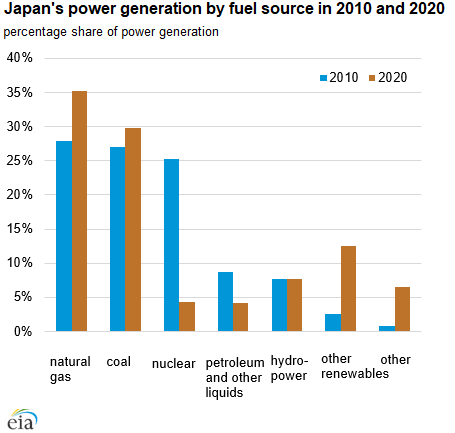 Source: Graph by the U.S. Energy Information Administration (EIA), based on data from BP Statistical Review of World Energy 2021.
Source: Graph by the U.S. Energy Information Administration (EIA), based on data from BP Statistical Review of World Energy 2021.
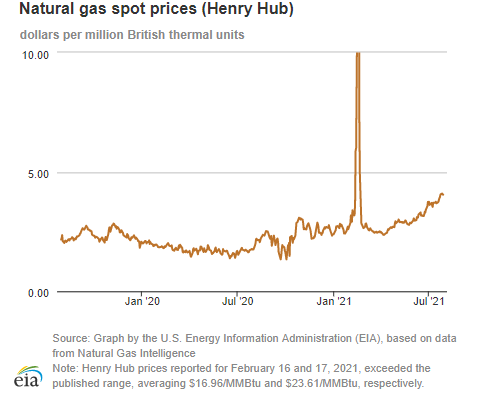
| Spot Prices ($/MMBtu) | Thu, 22-Jul |
Fri, 23-Jul |
Mon, 26-Jul |
Tue, 27-Jul |
Wed, 28-Jul |
|---|---|---|---|---|---|
| Henry Hub |
3.95 |
4.06 |
4.09 |
4.06 |
4.05 |
| New York |
3.15 |
3.55 |
3.95 |
3.56 |
3.12 |
| Chicago |
3.75 |
3.87 |
3.96 |
3.91 |
3.86 |
| Cal. Comp. Avg.* |
4.88 |
4.63 |
4.86 |
4.91 |
5.41 |
| Futures ($/MMBtu) | |||||
| August contract | 4.003 |
4.060 |
4.102 |
3.971 |
4.044 |
| September contract |
3.982 |
4.042 |
4.082 |
3.942 |
3.967 |
| *Avg. of NGI's reported prices for: Malin, PG&E Citygate, and Southern California Border Avg. | |||||
| Source: NGI's Daily Gas Price Index | |||||
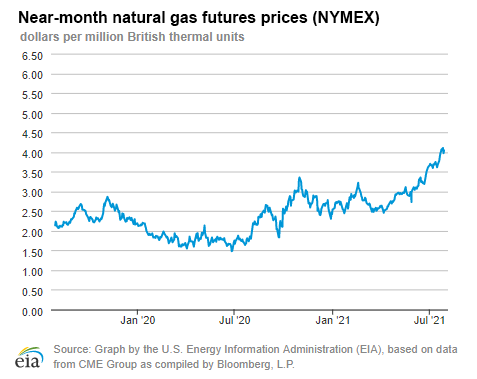
| U.S. natural gas supply - Gas Week: (7/22/21 - 7/28/21) | |||
|---|---|---|---|
Average daily values (billion cubic feet) |
|||
this week |
last week |
last year |
|
| Marketed production | 104.5 |
105.0 |
101.2 |
| Dry production | 92.6 |
92.9 |
89.6 |
| Net Canada imports | 5.6 |
5.0 |
4.1 |
| LNG pipeline deliveries | 0.1 |
0.1 |
0.2 |
| Total supply | 98.3 |
98.0 |
93.9 |
|
Source: Chart by the U.S. Energy Information Administration (EIA), based on data from IHS Markit | |||
| U.S. natural gas consumption - Gas Week: (7/22/21 - 7/28/21) | |||
|---|---|---|---|
Average daily values (billion cubic feet) |
|||
this week |
last week |
last year |
|
| U.S. consumption | 69.1 |
66.7 |
73.4 |
| Power | 40.8 |
38.6 |
44.5 |
| Industrial | 20.0 |
20.2 |
20.7 |
| Residential/commercial | 8.3 |
7.9 |
8.1 |
| Mexico exports | 6.3 |
6.3 |
6.0 |
| Pipeline fuel use/losses | 6.4 |
6.3 |
6.4 |
| LNG pipeline receipts | 10.7 |
10.4 |
3.3 |
| Total demand | 92.6 |
89.8 |
89.1 |
|
Source: Chart by the U.S. Energy Information Administration (EIA), based on data from IHS Markit | |||
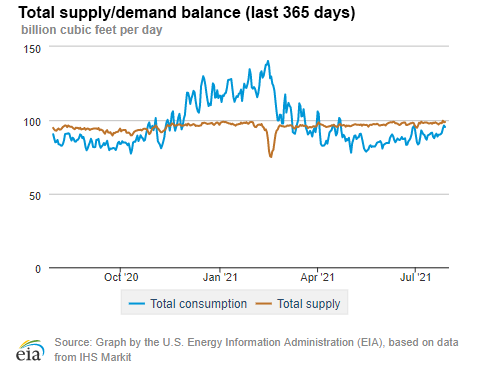
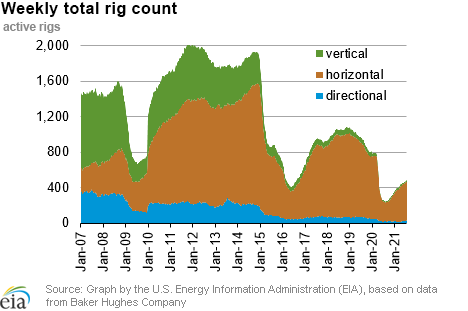
| Rigs | |||
|---|---|---|---|
Tue, July 20, 2021 |
Change from |
||
last week |
last year |
||
| Oil rigs | 387 |
1.8% |
113.8% |
| Natural gas rigs | 104 |
0.0% |
52.9% |
| Note: Excludes any miscellaneous rigs | |||
| Rig numbers by type | |||
|---|---|---|---|
Tue, July 20, 2021 |
Change from |
||
last week |
last year |
||
| Vertical | 19 |
5.6% |
35.7% |
| Horizontal | 439 |
1.2% |
104.2% |
| Directional | 33 |
3.1% |
50.0% |
| Source: Chart by the U.S. Energy Information Administration (EIA), based on data from Baker Hughes Company | |||
| Working gas in underground storage | ||||
|---|---|---|---|---|
Stocks billion cubic feet (Bcf) |
||||
| Region | 2021-07-23 |
2021-07-16 |
change |
|
| East | 583 |
562 |
21 |
|
| Midwest | 702 |
683 |
19 |
|
| Mountain | 184 |
183 |
1 |
|
| Pacific | 246 |
247 |
-1 |
|
| South Central | 999 |
1,002 |
-3 |
|
| Total | 2,714 |
2,678 |
36 |
|
|
Source: U.S. Energy Information Administration Form EIA-912, Weekly Underground Natural Gas Storage Report | ||||
| Working gas in underground storage | |||||
|---|---|---|---|---|---|
Historical comparisons |
|||||
Year ago (7/23/20) |
5-year average (2016-2020) |
||||
| Region | Stocks (Bcf) |
% change |
Stocks (Bcf) |
% change |
|
| East | 704 |
-17.2 |
636 |
-8.3 |
|
| Midwest | 813 |
-13.7 |
715 |
-1.8 |
|
| Mountain | 195 |
-5.6 |
181 |
1.7 |
|
| Pacific | 313 |
-21.4 |
289 |
-14.9 |
|
| South Central | 1,212 |
-17.6 |
1,060 |
-5.8 |
|
| Total | 3,237 |
-16.2 |
2,882 |
-5.8 |
|
| Source: U.S. Energy Information Administration Form EIA-912, Weekly Underground Natural Gas Storage Report | |||||
| Temperature – heating & cooling degree days (week ending Jul 22) | ||||||||
|---|---|---|---|---|---|---|---|---|
HDDs |
CDDs |
|||||||
| Region | Current total |
Deviation from normal |
Deviation from last year |
Current total |
Deviation from normal |
Deviation from last year |
||
| New England | 0 |
-1 |
-1 |
54 |
10 |
-6 |
||
| Middle Atlantic | 1 |
-1 |
1 |
68 |
9 |
-20 |
||
| E N Central | 1 |
-1 |
1 |
47 |
-11 |
-32 |
||
| W N Central | 0 |
-3 |
-1 |
62 |
-10 |
-12 |
||
| South Atlantic | 0 |
0 |
0 |
99 |
1 |
-23 |
||
| E S Central | 0 |
0 |
0 |
86 |
-9 |
-32 |
||
| W S Central | 0 |
0 |
0 |
111 |
-14 |
-25 |
||
| Mountain | 0 |
-4 |
0 |
88 |
9 |
-5 |
||
| Pacific | 1 |
-3 |
1 |
62 |
18 |
12 |
||
| United States | 1 |
-1 |
0 |
76 |
1 |
-17 |
||
|
Source: Chart by the U.S. Energy Information Administration (EIA), based on data from the National Oceanic and Atmospheric Administration Note: HDDs=heating degree days; CDDs=cooling degree days | ||||||||
Average temperature (°F)
7-day mean ending Jul 22, 2021
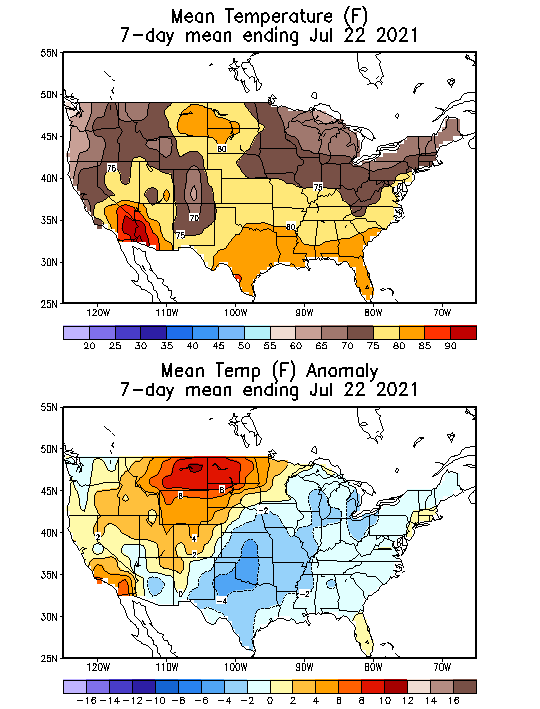
Source: National Oceanic and Atmospheric Administration
Deviation between average and normal (°F)
7-day mean ending Jul 22, 2021

Source: National Oceanic and Atmospheric Administration

